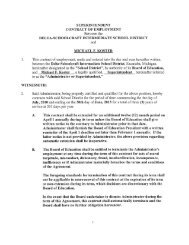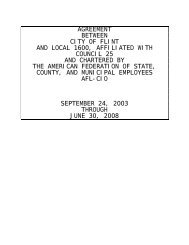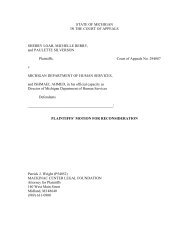The Cost of Remedial Education - Mackinac Center
The Cost of Remedial Education - Mackinac Center
The Cost of Remedial Education - Mackinac Center
You also want an ePaper? Increase the reach of your titles
YUMPU automatically turns print PDFs into web optimized ePapers that Google loves.
<strong>The</strong> <strong>Cost</strong> <strong>of</strong> <strong>Remedial</strong> <strong>Education</strong>:<br />
<strong>Mackinac</strong> <strong>Center</strong> for Public Policy How Much Michigan Pays When Students Fail to Learn Basic Skills<br />
the government in Michigan public institutions is $28 million. Extrapolating to the entire<br />
United States, our estimate <strong>of</strong> the same costs included in the estimates produced by<br />
Breneman, Haarlow, and Phipps would be $773 million nationally.<br />
Based on this comparison <strong>of</strong> government costs, the calculation <strong>of</strong> costs produced by<br />
Strategy 1 is likely to be conservative. <strong>The</strong> expenditures by Michigan employers are also<br />
likely to be a low estimate for reasons discussed at greater length in the following section.<br />
Our lowest reasonable estimate <strong>of</strong> the cost in Michigan <strong>of</strong> addressing a lack <strong>of</strong> basic skills<br />
after high school is $311 million per year.<br />
Businesses<br />
purchase<br />
technology to make<br />
up for the lack <strong>of</strong><br />
basic skills among<br />
workers in ways<br />
that even the<br />
employers do not<br />
fully recognize.<br />
Table 1 – Calculating the Annual <strong>Cost</strong> <strong>of</strong><br />
<strong>Remedial</strong> <strong>Education</strong> in Michigan: Strategy 1<br />
Annual <strong>Cost</strong> to:<br />
In Millions <strong>of</strong> Dollars:<br />
Community Colleges $65<br />
Four-Year Colleges $24<br />
Businesses $222<br />
Total<br />
$311 (rounded to the nearest million)<br />
Strategy 2: Re-Calculating the <strong>Cost</strong> to Employers<br />
While $222 million spent by Michigan businesses each year to address high school<br />
graduates’ lack <strong>of</strong> basic skills may seem like a high estimate, it is probably far lower than the<br />
true cost. As mentioned above, businesses purchase technology to make up for the lack <strong>of</strong><br />
basic skills among workers in ways that even the employers do not fully recognize. Things<br />
as trivial as “spell-check” on word-processing programs or inventory control information<br />
systems are purchased at least in part to compensate for the inability <strong>of</strong> workers to perform<br />
similar functions without the technology. Employers’ reports <strong>of</strong> expenditures on technology<br />
for this purpose are therefore likely to be grossly understated.<br />
In addition, many businesses suffer because they cannot or do not provide employees<br />
with remedial education. It is clear from the survey comments that many businesses simply<br />
endure what they must with workers lacking basic skills, without teaching those workers and<br />
without purchasing technology to substitute. This imposes a significant cost on businesses in<br />
the form <strong>of</strong> lowered productivity. A reasonable estimate <strong>of</strong> the costs <strong>of</strong> the lack <strong>of</strong> basic<br />
skills among Michiganians out <strong>of</strong> high school ought to include the cost <strong>of</strong> this lost<br />
productivity.<br />
In Strategy 2, we attempt to come up with a way to measure how much Michigan<br />
employers either spend to address the lack <strong>of</strong> skills among workers or lose in productivity as<br />
a result <strong>of</strong> those unremediated workers. In doing so, the impossibility <strong>of</strong> isolating exactly<br />
how many workers in how many different jobs lack basic skills, the myriad possible workrelated<br />
consequences <strong>of</strong> this lack, and their various impact on productivity, forces us to make<br />
some key assumptions. In the absence <strong>of</strong> an exact measure, the next best option is to<br />
discover the most easily comparable and also quantifiable value that could conceivably<br />
substitute for the exact, per-year value <strong>of</strong> lost productivity.<br />
10 September 2000













